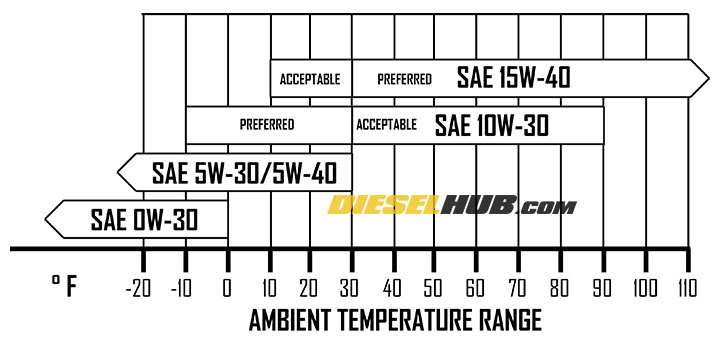The 4.5L Power Stroke diesel is a Ford branded VT275 turbodiesel designed and manufactured by International-Navistar. The engine's design is quite similar to the VT365, or in Ford Super Duty applications, the 6.0L Power Stroke. This engine is found exclusively in Ford LCF and International CF cab-over trucks built between 2005 and 2009. It is rated at a peak 200 horsepower and 440 lb-ft of torque and has a dry engine weight of approximately 835 pounds.
4.5 Power Stroke - A Scaled Down 6.0 Power Stroke
The 4.5L Power Stroke is typically referenced as a scaled down, V-6 sibling of the 6.0L Power Stroke V-8. While this does explain many of their similarities, the engines are quite different beyond basic system designs and parts commonality, looking at the engine and all of its components, is minimal. Dimensionally, both engines share a 3.74 inch bore diameter and 4.134 inch stroke length accommodating an 18.0 to 1 compression ratio. While the 4.5L shares a similar HEUI injection system, the fuel injectors and oil rail geometries are quite different.
Primary Design Differences
The 4.5L Power Stroke is more reminiscent of an engine targeted to commercial applications; its overall power density and maximum operating speed are significantly lower. Although it is 25% smaller than the 6.0L, the 4.5L is rated at 47% less power and only revs to approximately 2,800 rpm. As maintenance requirements and expectations tend to differ in commercial markets, the 4.5L uses an extended life engine coolant (ELC) with a recommended service life of 300,000 miles; significantly greater than the 6.0L Power Stroke achieves on Motorcraft Gold coolant.
Balance Shaft
One of the greatest fundamental differences between the 6.0L and 4.5L Power Stroke is the latter's gear driven balance shaft, which is used to resolve the couple imbalance inherent in the V-6 engine and its inability to counter inertial forces created by the reciprocating assembly. The balance shaft, which runs parallel to the crankshaft and through the hollow center of the camshaft, is designed with counterweights at either end. It is driven at crankshaft speed, but in the opposite direction, by the rear situated geartrain that also drives the camshaft and high pressure oil pump. The timing of the balance shaft to the crankshaft is critical in isolating and countering the couple imbalance, which would otherwise produce harsh vibrations and operating characteristics.
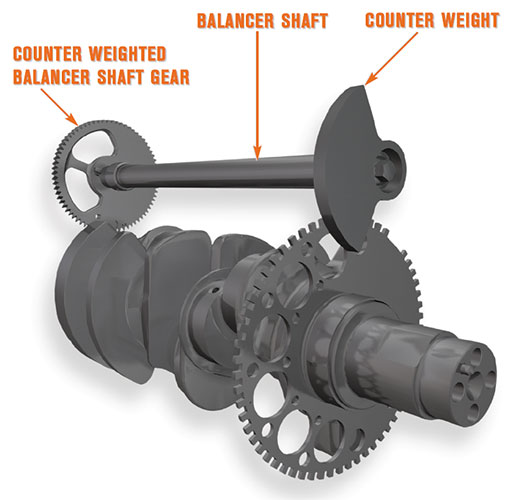
Twin Turbochargers
The 4.5L Power Stroke utilizes twin sequential turbochargers, a far cry from the single variable geometry turbo found on the 6.0L Power Stroke. The pair of fixed geometry turbochargers is wastegated to control peak manifold pressure and prevent an over-spool condition. In the sequential arrangement, the engine utilizes a small high pressure turbocharger and a larger low pressure turbocharger.
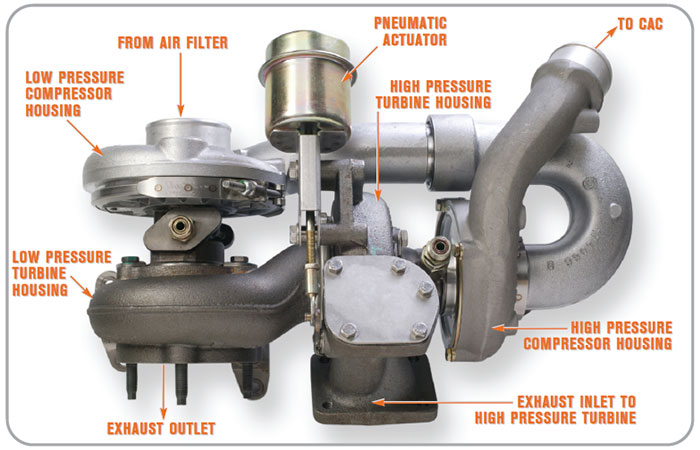
Exhaust gases pass through the high pressure turbo first, followed by the low pressure turbo. However, air is drawn from the air filter and through the compressor of the low pressure turbo first, then through the high pressure turbo and into the intercooler. This arrangement produces minimal lag because the high pressure turbo has a significantly smaller compressor and thus spools quickly. The low pressure turbo, by comparison, takes longer to spool but its larger compressor provides significantly more airflow. When peak manifold pressure is realized, the wastegate actuator is opened and a portion of exhaust gases bypass the high pressure turbine housing, limiting its rotational velocity.
Mass Airflow Sensor
One of the 4.5L Power Stroke's various sensors includes a mass airflow sensor, which are not particularly common on diesel engines from this period. It is significantly more common for engines of this generation, including the 6.0L Power Stroke, to calculate mass airflow using intake air temperature and manifold absolute pressure. By knowing the air density and pressure, airflow can be presumed for the purpose of fuel injection rates. Employing a mass airflow sensor, however, reduces any error in these calculated values and provides more precise airflow information to the PCM/ECM.
4.5 Power Stroke Applications
The 4.5L Power Stroke and VT275 are found exclusively in Ford LCF and International CF cab-over trucks. The Ford LCF is available in two submodels; the L45, which has a GVWR between 15,000 and 16,000 pounds and the L55, which has a GVWR between 17,999 and 19,500 pounds. In some parts catalogs, the L45 and L55 are referenced as the F500 and F600, although these names are not found in promotional information for the Ford LCF.
The International CF is also available in two submodels; the CF500 and CF600, which has similar GVWR ranges as the Ford LCF. LCF and CF trucks were only available with a 4.88 or 5.38 Dana Spicer rear end and Ford 5R110W TorqShift automatic transmission. International began offering the CF cab-over truck line in 2005 while Ford brought the LCF to market for the 2006 model year. Both vehicles ceased production following the 2009 model year.
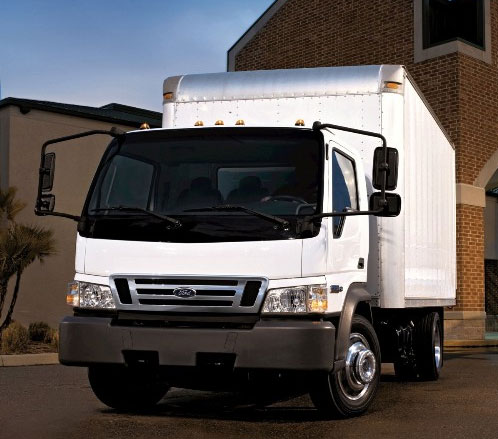
4.5 Power Stroke Engine Specs
| Engine | International VT275, 4.5L Power Stroke, later MaxxForce 5 |
| Type & Configuration | 4 stroke diesel, 90° V-6 |
| Applications | 2006 - 2009 Ford LCF L45, L55 (Low Cab Forward) 2005 - 2009 International CF500, CF600 |
| Advertised Displacement | 4.5 liters, 275 cubic inches |
| Calculated Displacement | 4.46 liters, 272.35 cubic inches |
| B10 Life | 250,000 miles |
| B50 Life | 408,500 miles |
| Bore | 3.74 inches (95.00 mm) |
| Stroke | 4.134 inches (105.00 mm) |
| Bore/Stroke Ratio | 0.90 (undersquare) |
| Compression Ratio | 18.0 : 1 |
| Firing Order | 1-2-5-6-3-4 |
| Cylinder Numbers |  Cylinders 1, 3, and 5 are located on the passenger side bank; cylinders 2, 4, and 6 are located on the driver side bank |
| Engine Block Material | Cast iron |
| Cylinder Head Material | Cast iron with aluminum rocker arm carrier |
| Injection System | HEUI generation 2 injection system |
| Aspiration | Twin sequential turbochargers, air-to-air intercooler |
| Reciprocating Assembly | 1 piece lower crankcase assembly (no bearing caps, single cast iron unit) Fractured cap connecting rods |
| Valvetrain | Standard pushrod overhead valve (OHV), 4 valves per cylinder (24 valve) |
| Cold Start Aid(s) | Glow plugs, 1 per cylinder |
| Engine Oil Capacity | 15 U.S. quarts with oil filter change |
| Engine Oil Spec | SAE 15W-40 typically preferred; see viscosity chart & conditions below |
| Lube Oil Filter | Motorcraft FL-2029 |
| Fuel | Ultra low sulfur diesel fuel (#1, #2, winterized blends of ULSD) Not rated for biodiesel blends in excess of B5 |
| Fuel Filter | Motorcraft FD-4596 |
| Horsepower | 200 hp @ 2,700 rpm |
| Torque | 440 lb-ft @ 1,800 rpm |
| Idle Speed | 700 rpm |
| Governed Speed | 2,775 rpm (max full load shift speed) |
| Coupled Transmission(s) | Ford 5R110W TorqShift five speed automatic |
| Engine Weight | Approx. 835 lbs dry |
Horsepower & Torque Curves
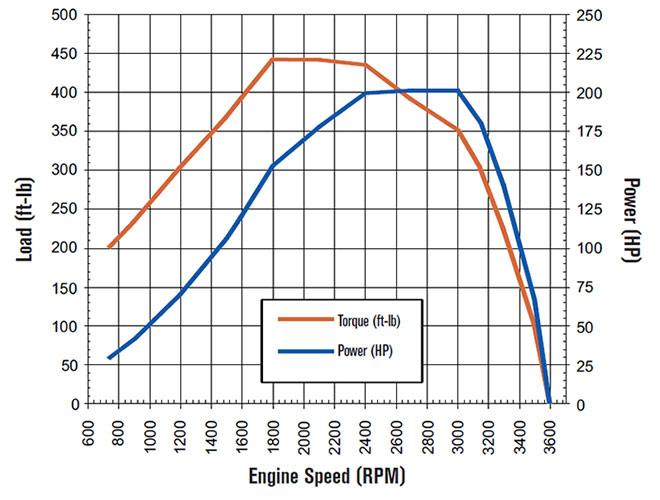
The 4.5L Power Stroke peaks at 200 horsepower and 440 lb-ft of torque. It displays a strong mid-range output with peak torque coming in smoothly at 1,800 rpm and carrying near-peak torque through 2,500 rpm. Power peaks near 2,400 rpm and holds steady through 3,000 rpm, although the transmission's maximum shift speed is just before 2,800 rpm.
Oil Viscosity Chart
The 4.5L Power Stroke requires an API category CI-4/SL, CI-4 PLUS, or equivalent specification engine oil. SAE 15W-40 engine oils are preferred in ambient temperatures of 30° F and greater while SAE 10W-30 motor oils are preferred in ambient temperatures between -10° F and 30° F; selecting an engine oil listed as "preferred" within the applicable temperature range provides ideal engine protection.
